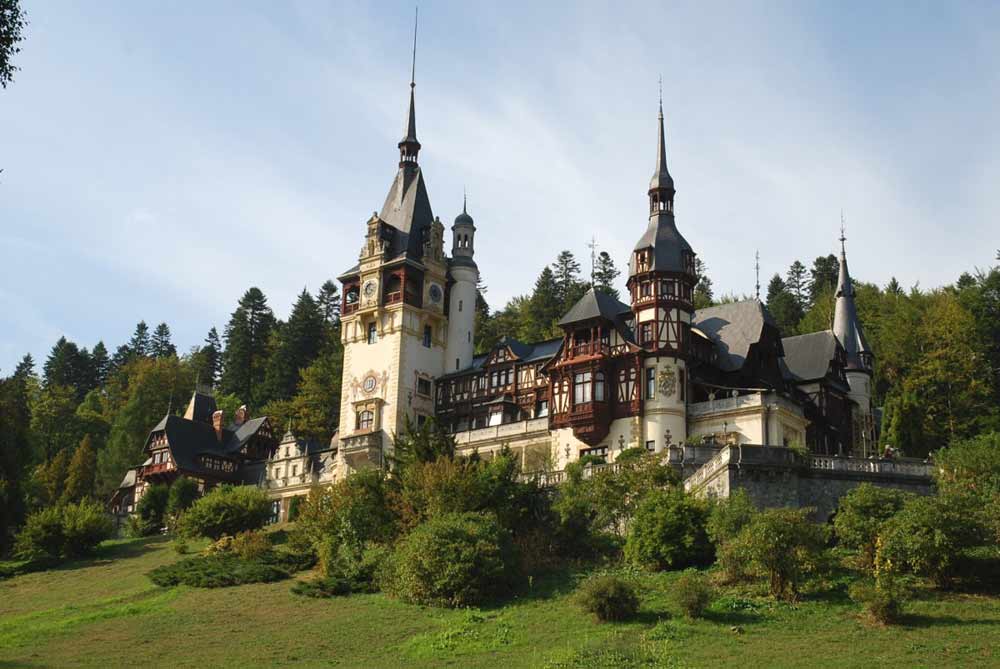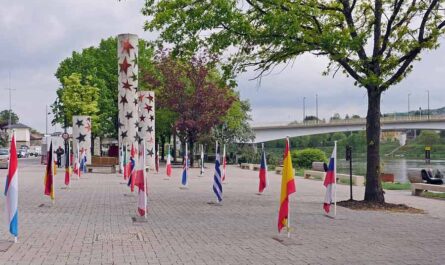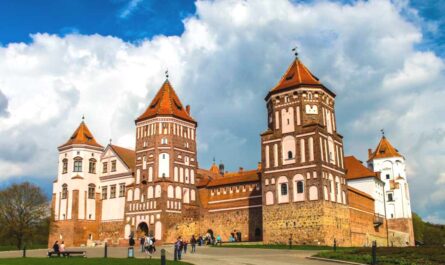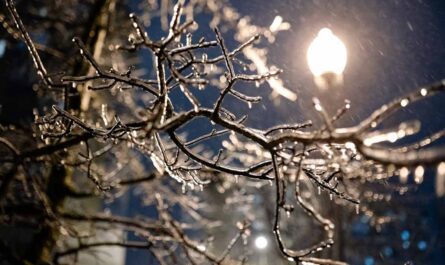There are a lot of interesting facts about Romania you will love to know. The etymology of Romania’s name reflects a fascinating linguistic evolution, mirroring the country’s historical trajectory. Initially derived from the French “Roumania” or “Roumanie,” the country’s moniker morphed into “Rumania” before settling on its current iteration after the tumult of World War II: “Romania.” This metamorphosis of nomenclature encapsulates the interplay of cultural influences and historical forces that have shaped Romania’s identity over the centuries.
Interesting facts about Romania
Romania’s network of rivers, crisscrossing the landscape, holds immense significance. Not only do these rivers provide sustenance to the surrounding ecosystems, but they also harness the power of flowing water to generate hydroelectricity, a cornerstone of the nation’s energy infrastructure. Furthermore, Romania’s coastline along the Black Sea is adorned with bustling ports and vibrant resorts, adding a maritime dimension to its natural bounty. This wealth of resources not only shapes Romania’s landscape but also forms the backbone of its economy, driving growth and prosperity across the nation. Let’s enjoy these interesting facts about Romania!
1. Battlegrounds of Ambition: Romania Amidst the Great Powers’ Machinations
For six centuries following its inception, Romania found itself ensnared within the geopolitical chessboard, where its territories became the crucible for neighboring powers’ conflicting ambitions. The Romanian people, ensconced amidst the tumultuous currents of history, grappled with the ceaseless encroachments of imperial agendas. From the Byzantine hegemony to the relentless pressures exerted by the Ottoman Turks in Constantinople, Romania stood as a bastion against external dominion. Furthermore, the pervasive reach of the Habsburg Empire from the west and the looming specter of Russian influence from the east cast a shadow over Romania’s sovereignty, rendering it a pawn in the grand tapestry of European power struggles.
2. The Dawn of Independence: Romania’s Quest for Sovereignty
In a momentous juncture of history, the principalities of Walachia and Moldavia, two bastions of Romanian identity, converged in 1859, heralding a pivotal chapter in Romania’s quest for self-determination. The declaration of independence from the Ottoman Empire in 1877 marked a watershed moment, symbolizing Romania’s defiant stride towards sovereignty. This seismic shift was not merely political but cultural, as Romania embraced the Latin alphabet, severing ties with the Cyrillic script that bore the vestiges of Byzantine influence. Additionally, the exodus of eager students seeking enlightenment in the salons of Western Europe, notably France, underscored Romania’s fervent embrace of modernity and intellectual enlightenment.
3. Romania’s Intellectual Legacy: From the Forge of History to the Annals of Achievement
Despite its belated emergence as a cohesive European nation-state, Romania emerged as a crucible of intellectual brilliance in the 20th century, leaving an indelible mark on the global stage. The pantheon of Romanian luminaries boasts names that resonate across disciplines, from the mellifluous compositions of Georges Enesco to the existential musings of Eugène Ionesco. Philosophical profundity found its voice in the works of Emil Cioran, while the religious historiography of Mircea Eliade illuminated the corridors of human spirituality. Moreover, George E. Palade’s groundbreaking contributions to cellular biology culminated in a Nobel laureate, reaffirming Romania’s enduring legacy of scholarly excellence. As we delve deeper into Romania’s captivating narrative, prepare to be enthralled by the kaleidoscope of its cultural riches and intellectual luminaries.
4. A Gastronomic Journey: Exploring Romania’s Culinary Delights
Embark on a culinary odyssey through the heartland of Romania and discover a cornucopia of flavors that tantalize the taste buds and nourish the soul. From the hearty embrace of Sarmale (Cabbage Rolls) to the comforting allure of Mămăligă (Polenta), Romanian cuisine offers a feast for the senses. Indulge in the succulent perfection of Mici (Grilled Minced Meat Rolls) or savor the robust flavors of Ciorbă de burtă (Beef Tripe Soup). Delight in the festive tradition of Pomana Porcului (Honoring The Pig) or relish the rustic charm of Jumări (Greaves). Complete your culinary journey with the sweet embrace of Cozonac (Sweet Bread) or the savory sophistication of Drob de miel (Lamb Haggis). Each dish, steeped in tradition and imbued with love, tells a story of Romania’s rich culinary heritage.
5. Romania’s Trade Tapestry: Unraveling the Threads of Import Diversity
At the crossroads of Europe, Romania’s trade landscape paints a vibrant tableau of diversity and economic vitality. A kaleidoscope of imports floods Romania’s markets, ranging from succulent meats to luscious fruits and nuts, from creamy dairy products to crusty breads. Delve deeper, and you’ll uncover a mosaic of food preparations, soybean delights, and verdant vegetables. Amidst this tapestry, spirits mingle with cereals, oilseeds dance with culinary oils, each import weaving a thread in Romania’s economic tapestry. This kaleidoscope of imports not only fuels Romania’s economy but also enriches its cultural fabric, embodying the nation’s spirit of openness and interconnectedness with the wider world.
6. Conquering Curves: The Transfagarasan Highway’s Driving Delight
Renowned automotive aficionado Jeremy Clarkson heralded the Transfagarasan Highway as the “world’s greatest driving route,” unveiling Romania’s hidden gem to the global stage. Nestled within the heart of Romania, this asphalt marvel stands as a testament to engineering prowess, weaving through the rugged terrain of the Southern Carpathians with breathtaking audacity. Adorned with tunnels, viaducts, and bridges, the Transfagarasan Highway challenges drivers with a symphony of hairpin curves, pushing the limits of handling and exhilarating the senses. Yet, beyond its adrenaline-inducing allure, the highway carries a legacy intertwined with political intrigue, conceived by Nicolae Ceaușescu as an escape route in the event of a Soviet invasion. As travelers navigate its serpentine bends, they embark on a journey through Romania’s storied past and unparalleled natural beauty.
7. Mucenici: Sweet Remnants of Ancient Sacrifice
Delve into the annals of Romanian culinary tradition, and you’ll uncover a delightful confection with roots reaching back to ancient Armenia’s tragic tale. Mucenici, or sfinti, are sweet dough cookies adorned with a honey and nut coating, fashioned into the shape of an eight. This symbolic form pays homage to the sacrifice of 40 Christian warriors millennia ago, immortalizing their valor in delectable treats. As each bite of mucenici transports taste buds through layers of sweetness and nostalgia, it serves as a poignant reminder of the enduring power of tradition and the resilience of the human spirit.
8. Romania’s Spirited Soul: A Nation of Libations
In the tapestry of global imbibing, Romania stands tall as the world’s fifth-most boozy country, following in the footsteps of its Eastern European counterparts: Belarus, Russia, Moldova, and Lithuania. Year after year, the typical Romanian imbibes a staggering 14.4 liters of pure alcohol, surpassing even the libation-loving denizens of the United Kingdom. From the heady depths of local ţuică to the effervescent embrace of Moldavian wine, Romania’s spirited soul finds expression in every toast and celebration. Yet, amidst the revelry, lies a nuanced reflection of cultural identity and social dynamics, where the clinking of glasses echoes the joys and sorrows of Romanian life.
9. Toasting Tradition: Romania’s Love Affair with Libations
In the global pantheon of libations, Romania emerges as a spirited contender, ranking 16th in wine consumption and 10th in beer consumption worldwide. This revelation comes as no surprise, considering Romania’s esteemed status as one of the globe’s major wine producers. From the rolling vineyards of Transylvania to the sun-kissed slopes of Moldova, Romania’s viticultural landscape yields a bounty of wines cherished by connoisseurs far and wide. Meanwhile, the frothy allure of Romanian beer beckons enthusiasts to savor the crisp refreshment of locally brewed brews. With each clink of the glass, Romanians celebrate their rich cultural heritage and the timeless tradition of raising a toast to life’s joys and triumphs.
10. A Medical Milestone: Nicolae Paulescu and the Discovery of Insulin
In the annals of medical history, Nicolae Paulescu stands as a pioneer of unparalleled ingenuity, credited with a groundbreaking discovery that revolutionized diabetes treatment. In 1916, Paulescu’s experiments with pancreatic extracts yielded a remarkable breakthrough: the normalization of blood sugar levels in a diabetic dog. This astonishing outcome heralded the advent of insulin, a life-saving elixir that would transform the lives of millions worldwide. Paulescu’s legacy as the creator of insulin in Romania endures as a testament to the power of scientific inquiry and the boundless potential of human innovation in the pursuit of healing.
11. Babele: Romania’s Weather Divination Ritual
As the new year dawns upon Romania, anticipation fills the air, as curious souls seek glimpses of what the future holds. Amidst the age-old rituals that punctuate the passage of time, Babele emerges as a whimsical tradition that offers a tantalizing peek into the year ahead. Participants embark on a playful journey of weather divination, selecting a date between March 1st and March 9th to unveil the weather’s prophecy for the coming year. Yet, in a twist of fate, modern conveniences such as the weather channel must be eschewed, as participants rely solely on nature’s whims to unveil the secrets of tomorrow. With each whimsical prediction, Romanians embrace the mysteries of fate and the enduring allure of ancient traditions that bind them to the rhythms of the natural world.
12. Divine Blessings: Romanian Traditions of Priestly Benediction
In the fabric of Romanian society, the role of the priest extends beyond spiritual guidance to encompass a realm of supernatural belief and ritualistic practice. Embedded within the cultural consciousness is a reverence for the perceived abilities of priests to bestow blessings upon various facets of life. Thus, it is not uncommon for Romanians to seek the intervention of priests to sanctify not only homes and automobiles but also garments and even skeptical family members. This ritual of blessing, steeped in tradition, serves as a symbolic gesture of protection and divine favor. Yet, for those who evade the priest’s benediction, a peculiar consequence awaits: the indelible mark of a stinky cross adorning their forehead, a humorous reminder of the intertwining of superstition and faith in Romanian culture.
13. Palinca de Prune: A Spirited Distillation of Romanian Tradition
In the rustic heartland of Romania, a centuries-old tradition of distillation yields a potent elixir known as Palinca de prune. Crafted from the effervescent bounty of plums, this 100 percent natural spirit undergoes a meticulous process of twice distilling, culminating in a libation of unrivaled purity and intensity. With each sip, connoisseurs are transported on a sensory journey through the verdant orchards and sun-drenched hillsides that define Romania’s agricultural landscape. Palinca de prune stands as a testament to the enduring legacy of Romanian craftsmanship, embodying the essence of tradition and terroir in every velvety drop.
14. Eugen Pavel: A Luminary of Scientific Innovation
Amidst the annals of scientific achievement, Eugen Pavel emerges as a towering figure of innovation, his contributions spanning the realms of optical storage technology. As the inventor of the Hyper CD-ROM, Pavel revolutionized data storage with a 1 million GB optical data storage system, eclipsing conventional limitations and paving the way for unprecedented advancements in information technology. Armed with a doctorate in physics and a relentless spirit of inquiry, Pavel’s brilliance shines through in the form of 62 patents, each a testament to his boundless ingenuity and commitment to pushing the boundaries of scientific possibility. In the hallowed halls of Romanian academia, Eugen Pavel’s legacy endures as a beacon of inspiration for generations of aspiring scientists and innovators.
15. Romania: A Tapestry of Marvels and Wonders
From the rugged peaks of the Carpathian Mountains to the meandering waters of the Danube Delta, Romania is a land teeming with natural beauty and cultural splendor. Its architectural treasures, ranging from medieval castles to modernist masterpieces, bear witness to a rich tapestry of history and innovation. Meanwhile, its diverse landscapes, from lush forests to sun-kissed vineyards, offer endless opportunities for exploration and discovery. But perhaps most remarkable of all are the people of Romania, whose warmth, resilience, and hospitality infuse every corner of the nation with a sense of vitality and charm. As a testament to its allure, Romania boasts Europe’s best-preserved delta and the world’s largest outdoor museum, inviting travelers to embark on a journey of wonder and enchantment. With each step, Romania reveals itself as a land of endless fascination and boundless possibility, where the extraordinary awaits at every turn.
16. Bigăr Waterfall: Nature’s Unique Masterpiece
Nestled amidst the majestic Carpathian Mountains of Romania lies a natural wonder unlike any other: the Bigăr Waterfall. Tucked away in the Anina Mountains, this enchanting cascade captivates visitors with its mesmerizing beauty and ethereal charm. What sets Bigăr apart is its distinctive cascading streams, which flow delicately over moss-covered rocks in a captivating display of natural artistry. Such is its allure that the Bigăr Waterfall earned a coveted spot on World Geography’s list of ‘Unique Waterfalls Around the World,’ a testament to its status as a hidden gem waiting to be discovered by intrepid adventurers and nature enthusiasts alike.

17. Glod: A Village of Cinematic Controversy
In the annals of cinematic history, the Romanian village of Glod occupies a peculiar place, immortalized as the backdrop for Sacha Baron Cohen’s satirical masterpiece, Borat. Portrayed as the fictional Kazakh homeland of the titular character, Glod’s Roma population was enlisted as extras to lend authenticity to the film’s narrative. However, what began as a cinematic venture soon turned controversial when some of the extras, unaware of the film’s subject matter, attempted to sue the production for misrepresentation. Despite their efforts, the lawsuit ultimately faltered, leaving Glod forever entwined with the legacy of Borat and the complexities of cultural portrayal in cinema.
18. Romania’s Export Dynamics: A Global Marketplace
In the bustling corridors of international trade, Romania emerges as a key player, exporting a diverse array of goods to markets around the globe. Machinery and transportation equipment stand as the nation’s primary exports, alongside raw materials and manufactured goods such as textiles and footwear. Within the European Union, Romania finds its largest export partners in Germany, Italy, and France, nations that drive the demand for Romanian goods and foster economic growth. Beyond the confines of the EU, Turkey stands as another significant export destination, further underscoring Romania’s importance in the global marketplace and its role as a hub of commerce and innovation.
19. Romania’s Legacy of Innovation
In the annals of scientific achievement, Romania has carved out a distinguished legacy of innovation and discovery. Among its notable contributions to the world are the inventions of Nicolae Paulescu, Henri Coandă, and Petrache Poenaru. While Paulescu developed insulin—a groundbreaking advancement in the treatment of diabetes—his efforts went unrecognized, with two Canadian scientists ultimately receiving the Nobel Prize in 1923 for their research on the hormone. Meanwhile, Coandă revolutionized aviation with his invention of the modern jet engine, propelling the field of aerospace engineering into new frontiers. Additionally, Poenaru’s invention of the fountain pen ushered in a new era of writing instruments, transforming the way people record and communicate their thoughts. Together, these visionary innovators epitomize Romania’s spirit of ingenuity and its enduring commitment to pushing the boundaries of human knowledge.
20. Boboteaza: A Test of Courage
On January 6th, as Romania celebrates Boboteaza, males partake in a tradition that tests their mettle and bravery. Amidst the frigid waters of local rivers and lakes, they engage in a daring swim to retrieve a wooden cross thrown by Orthodox priests, symbolizing the baptism of Jesus. This ritual, steeped in religious significance and cultural tradition, serves as a rite of passage for young men, challenging them to demonstrate their courage and resolve in the face of adversity. Meanwhile, as women undertake the task of baking, males partake in another tradition, indulging in the consumption of rachiu—a potent alcoholic beverage—according to custom. Through these rituals, Boboteaza offers a glimpse into the rich tapestry of Romanian culture and the enduring spirit of community and camaraderie.
21. Romania’s Expansive Road Network
Despite its modest size in terms of land area, Romania boasts one of the world’s most extensive road networks, spanning an impressive 22,298 kilometers. Ranked as the 15th largest road network globally, Romania’s infrastructure facilitates connectivity and mobility across the nation, linking cities, towns, and rural communities alike. This feat of engineering underscores Romania’s commitment to transportation infrastructure and its role as a vital hub of commerce and industry in the region. As travelers traverse the country’s highways and byways, they bear witness to the remarkable legacy of Romania’s road network, a testament to the nation’s progress and development over the centuries.
22. High-Speed Internet: Romania’s Technological Edge
In the realm of digital connectivity, Romania stands out as a global leader, boasting internet speeds that surpass even those of the United States. With a peak internet speed of 58.7 Mbps, Romania ranks seventh in the world, outpacing the United States, which holds the 17th spot with a peak connection speed of 48.8 Mbps. This remarkable feat underscores Romania’s commitment to technological advancement and its status as a hub of innovation in the digital age. Moreover, Romania’s appetite for online content is unparalleled in Europe, with an average monthly traffic of 91 GB for fixed broadband lines, demonstrating the nation’s voracious appetite for digital consumption and its insatiable thirst for knowledge and connectivity.
23. Romanian Language: A Balkan Romance
At the heart of Romanian culture lies its language, a Balkan Romance tongue spoken by millions around the world. With approximately 22–26 million native speakers, predominantly in Romania and Moldova, and an additional 4 million speakers who use it as a second language, Romanian serves as a vibrant testament to the nation’s rich linguistic heritage. Rooted in Latin and infused with elements of Slavic, Greek, and Turkish influence, Romanian embodies the diverse tapestry of cultures that have shaped the region over centuries. From the rolling hills of Transylvania to the bustling streets of Bucharest, the melodic cadence of Romanian language echoes through the ages, connecting people across borders and generations.
24. Aurel Persu: Revolutionizing Automotive Design
In the annals of automotive history, Aurel Persu stands as a visionary pioneer whose innovative designs forever altered the course of automobile engineering. A Romanian engineer and automotive designer, Persu is credited with revolutionizing the appearance of automobiles by introducing the concept of integrating wheels within the body of the vehicle. Inspired by the principles of aerodynamics, Persu envisioned a car with a sleek and streamlined silhouette, resembling the shape of a water drop. In 1924, while in Germany, he received a patent for his groundbreaking design, paving the way for a new era of automotive innovation. Through his visionary contributions, Persu left an indelible mark on the automotive industry, shaping the aesthetic and functional evolution of automobiles for generations to come.
25. Decebalus: Romania’s Mount Rushmore
Nestled amidst the rugged beauty of the Iron Gates valley along the Danube River stands a remarkable sculpture that pays homage to Romania’s storied past. Created between 1994 and 2004, the Mount Rushmore sculpture portrays Decebalus, the last king of Dacia, who valiantly resisted the might of the Roman Empire. Carved into a rocky outcropping overlooking the river, this monumental tribute captures the spirit and resilience of a legendary ruler who defied imperial conquest. With its towering presence and intricate detail, the Mount Rushmore sculpture serves as a poignant reminder of Romania’s rich cultural heritage and its enduring legacy of courage and defiance in the face of adversity.
26. Wedding Traditions: A Celebration of Love and Heritage
In Romania, weddings are steeped in tradition and symbolism, with each ritual and ceremony reflecting the rich tapestry of the nation’s cultural heritage. Before the wedding ceremony begins, a procession of guests dressed in traditional attire sets the stage for the celebration to come. The best man carries a decorated pole, symbolizing strength and unity, while the midnight bridal dance ushers in the joyous festivities. As the evening unfolds, the bride and groom exchange vows and rings, followed by the presentation of wedding presents and the sharing of bread from an immense loaf, signifying prosperity and abundance in their union. Through these cherished traditions, Romanian weddings embody the essence of love, family, and community, uniting generations in a celebration of joy and togetherness. Motivation – Mind – Success – Thinking – Productivity – Happiness
27. Francesco Illy: A Legacy of Innovation
Born in the historic city of Timișoara, Romania, Francesco Illy left an indelible mark on the world of coffee with his pioneering vision and entrepreneurial spirit. As the founder of the renowned Italian coffee roasting company, Illy revolutionized the coffee industry, introducing innovative techniques and unparalleled quality standards. Despite his remarkable achievements, Illy’s legacy remains overshadowed by the towering figures of Romanian history, as evidenced by his exclusion from the 2006 list of the 100 Greatest Romanians. Nonetheless, his contributions to the world of coffee endure as a testament to his ingenuity and dedication, inspiring coffee lovers around the globe to savor the artistry and craftsmanship of a perfect cup of espresso.
28. Baia Mare’s Chestnut Festival: Setting World Records
In the quaint town of Baia Mare, Romania, the Chestnut Festival isn’t just a celebration of autumn’s bounty—it’s a showcase of record-breaking feats recognized by the Guinness World Records. Among its notable achievements is the production of the world’s largest bowl of goulash, a savory stew beloved by locals and visitors alike. This colossal culinary creation, boasting a whopping 7,200 liters of hearty goodness, exemplifies the town’s spirit of hospitality and gastronomic excellence. Additionally, Romanian business ING Asigurari de Viata made history by printing the world’s largest legal document, measuring an impressive nine meters by six meters. Through these remarkable accomplishments, Baia Mare’s Chestnut Festival has firmly secured its place on the global stage, drawing admiration and acclaim for its ingenuity and creativity.
Hopefully, you have enjoyed these interesting facts about Romania.
More Interesting Facts and Articles




